Venstre (Denmark)
Venstre[note 1] (Danish pronunciation: [ˈvenstʁɐ], literally "left"), full name Venstre, Danmarks Liberale Parti (English: Left, Denmark's Liberal Party), is a conservative-liberal,[2][3][4] agrarian[10] political party in Denmark. Founded as part of a peasants' movement against the landed aristocracy, today it espouses an economically liberal, pro-free-market ideology.[6]
Venstre, Denmark's Liberal Party Venstre, Danmarks Liberale Parti | |
|---|---|
| Leader | Jakob Ellemann-Jensen |
| Founded | 1870, total reform in 1910 |
| Headquarters | Søllerødvej 30 2840 Holte |
| Youth wing | Venstres Ungdom |
| Student wing | Liberal Students of Denmark |
| Membership (2016) | 35,957[1] |
| Ideology | Conservative liberalism[2][3][4] Agrarianism[4][5] Economic liberalism[6] |
| Political position | Centre-right[7] |
| European affiliation | Alliance of Liberals and Democrats for Europe |
| International affiliation | Liberal International |
| European Parliament group | Renew Europe |
| Nordic affiliation | Centre Group |
| Colours | Blue |
| Folketing: | 42 / 179 |
| European Parliament: | 4 / 14 |
| Regions:[8] | 688 / 2,444 |
| Municipalities:[9] | 688 / 2,432 |
| Mayors: | 37 / 98 |
| Election symbol | |
| V | |
| Website | |
| www | |
Venstre is the major party of the centre-right in Denmark, and the second-largest party in the country. The party has produced many Prime Ministers. In the 2019 general elections, Venstre received 23.4% of the vote and 43 out of 179 seats. Its current leader is Jakob Ellemann-Jensen following the resignation of Lars Løkke Rasmussen as chairman on 31 August 2019.[11]
The party is a member of Liberal International and the Alliance of Liberals and Democrats for Europe (ALDE) and has three MEPs in the European Parliament.[12]
Ideology
Venstre is categorised as centre-right on the political spectrum.[7] It is a market liberal party[13] within the Nordic agrarian tradition,[14] and today is notably more pro–free market than its sister parties.[15] Some describe it as classical liberal, since its leader from 1998 to 2009, Anders Fogh Rasmussen, is known for his authorship of the book From Social State to Minimal State. His book advocated an extensive reform of the Danish welfare state along classical liberal lines, including lower taxes and less government interference in corporate and individual matters.
Since the elections in 2001, Venstre has enacted a so-called "tax stop" in order to halt the growth in taxes seen during the previous eight years under the Social Democrats. This tax stop has been under heavy fire from the parties on the left wing of Danish politics, allegedly for being "asocial" and "only for the rich."[16][17]
History

1870–1910
Venstre was founded in 1870 under the name Det Forenede Venstre ("The United Left") and originally consisted of multiple conflicting groups, all united under the liberal ideology, the safeguarding of farmers' interests and opposition to the then conservative party Højre (literally "Right"). After the party in 1872 gained an absolute majority in the Folketing, it became the leading voice in the battle for parliamentarism, whereafter the party in 1895 split in two, Venstrereformpartiet ("Venstre Reform Party") and Det Moderate Venstre ("The Moderate Left"). In 1905, social liberal factions split from the party and formed Radikale Venstre (also known as the Danish Social Liberal Party), and in 1910 Venstrereformpartiet and Det Moderate Venstre reunited again under the name Venstre.[18]
1910–2009
With the decreasing numbers of farms and the growing urbanisation, membership and voter support dropped in the 1950s. During the 1960s the party gradually evolved from being a traditional farmers' party to a more general liberal party. In 1984 Uffe Ellemann-Jensen was elected chairman, and by profiling the liberal ideology in sharp confrontation to the Social Democrats, for example by campaigning for a reduction of the public sector, increasing market management and privatisation, and by being pro-EU, the party returned to its historical position as the biggest liberal party in the 1990s.[18]
After a disappointing 1998 general election, Ellemann-Jensen resigned as chairman and Anders Fogh Rasmussen was elected in his place. He immediately changed the party's usual confrontational strategy, instead appealing to the political centre. In the 2001 general elections the party campaigned for tighter immigration policies and a "tax stop", which proved successful and the party once again became the biggest in parliament, winning 31.2% of the vote and 56 seats. Venstre formed a coalition government with the Conservative People's Party and the Danish People's Party. For the first time since 1929 a liberal government was no longer dependent on the centre parties. Despite a small decline in both the 2005 general elections (29% and 52 seats) and the 2007 general elections (26.2% and 46 seats), the party remained the biggest and the coalition government continued.[18]
On 5 April 2009 Fogh Rasmussen resigned as chairman, instead serving as Secretary General of NATO. In his place Lars Løkke Rasmussen was elected.[19]
2009–present
In the 2011 general elections the gained 26.7% of the vote and 47 seats, but was not able to form a government, instead leading the opposition of Prime Minister Helle Thorning-Schmidt's Social Democratic coalition.
Even though the party lost voter support in the 2015 general elections, only gaining 19.5% of the vote, the party formed a minority government. This government was short lived, and in 2016 Løkke Rasmussen invited the Conservative People's Party and the Liberal Alliance to form a coalition government instead.[20]
During the campaign of the 2019 general elections Løkke Rasmussen published an autobiography, in which he opened up for the possibility of forming a government with the Social Democrats.[21] This was seen as controversial in the liberal "blue bloc", and Social Democratic leader Mette Frederiksen immediately declined the proposition.[22]
Following internal fighting in the party, Løkke Rasmussen and vice chairman Kristian Jensen both resigned on 31 August 2019. On 21 September 2019 political spokesman and former Minister for Environment and Food Jakob Ellemann-Jensen was elected the party's next chairman.[23]
Prime Ministers
- Johan Henrik Deuntzer (July 24, 1901 – January 14, 1905)
- Jens Christian Christensen (January 14, 1905 – October 12, 1908)
- Niels Neergaard (October 12, 1908 – August 16, 1909)
- Ludvig Holstein-Ledreborg (August 16, 1909 – October 28, 1909)
- Klaus Berntsen (July 5, 1910 – June 21, 1913)
- Niels Neergaard (May 5, 1920 – April 23, 1924)
- Thomas Madsen-Mygdal (December 14, 1926 – April 30, 1929)
- Knud Kristensen (November 7, 1945 – November 13, 1947)
- Erik Eriksen (October 30, 1950 – September 30, 1953)
- Poul Hartling (December 19, 1973 – February 13, 1975)
- Anders Fogh Rasmussen (November 27, 2001 – April 5, 2009)
- Lars Løkke Rasmussen (April 5, 2009 – October 3, 2011; June 28, 2015 – June 27, 2019)
Leaders since 1929
| No. | Portrait | Leader | Took office | Left office | Time in office |
|---|---|---|---|---|---|
| 1 | Thomas Madsen-Mygdal (1876–1943) | 1929 | 1941 | 11–12 years | |
| 2 | Knud Kristensen (1880–1962) | 1941 | 1949 | 7–8 years | |
| 3 | Edvard Sørensen (1893–1954) | 1949 | 1950 | 0–1 years | |
| 4 | Erik Eriksen (1902–1972) | 1950 | 24 May 1965 | 14–15 years | |
| 5 | Poul Hartling (1914–2000) | 24 May 1965 | December 1977 | 12 years, 191 days | |
| 6 | Henning Christophersen (1939–2016) | September 1978 | 23 July 1984 | 5 years, 326 days | |
| 7 | Uffe Ellemann-Jensen (born 1941) | 23 July 1984 | 18 March 1998 | 13 years, 238 days | |
| 8 | Anders Fogh Rasmussen (born 1953) | 18 March 1998 | 17 May 2009 | 11 years, 60 days | |
| 9 | Lars Løkke Rasmussen (born 1964) | 17 May 2009 | 31 August 2019 | 10 years, 106 days | |
| – | Kristian Jensen (born 1971) Acting | 31 August 2019 | 21 September 2019 | 21 days | |
| 10 | Jakob Ellemann-Jensen (born 1973) | 21 September 2019 | Incumbent | 330 days |
Origin of the name
The fact that the major centre-right political party in a country calls itself 'Left' is often confusing to foreign (and sometimes Danish) observers. The name has, however, its historical explanation. At the time of its foundation, Venstre affirmed then-progressive ideas in the Danish parliament. Their opponents, Højre (Right), the forerunner of the present-day Conservative People's Party, advocated for established interests, particularly the Church of Denmark and the landed gentry. In current Danish politics there is a clear distinction between the concepts of Venstre (Left, i.e., the party bearing that name) and venstrefløj (left wing, i.e., socialist and other left-leaning parties). The use of the word for "left" in the name of the Danish political party Radikale Venstre and the Norwegian party Venstre is meant to refer to liberalism and not socialism.
Members of the party are referred to as venstremænd and venstrekvinder, respectively "Venstre men" and "Venstre women" (singular: -mand, -kvinde).
Election results
Parliament
| Election year | # of overall votes | % of overall vote | % of Danish vote | # of overall seats won | # of Danish seats won | +/- | Notes |
|---|---|---|---|---|---|---|---|
| 1872 | 53 / 104 |
New | In Det Forenede Venstre. | ||||
| 1873 | 51 / 104 |
In Det Forenede Venstre. | |||||
| 1876 | 74 / 104 |
In Folketingets Venstre. | |||||
| 1879 | 65 / 104 |
In Folketingets Venstre. | |||||
| 1881 (may) | 69 / 102 |
In Folketingets Venstre. | |||||
| 1881 (jul) | 75 / 102 |
In Folketingets Venstre. | |||||
| 1884 | 80,000 | 56.3 (#1) | 81 / 102 |
In Venstre Reform Party. | |||
| 1887 | 132,000 | 58.1 (#1) | 74 / 102 |
In Venstre Reform Party. | |||
| 1890 | 123,000 | 53.0 (#1) | 75 / 102 |
In Venstre Reform Party. | |||
| 1892 | 63,000 | 28.1 (#3) | 30 / 102 |
In Venstre Reform Party. | |||
| 1895 | 89,530 | 40.5 (#1) | 53 / 114 |
In Venstre Reform Party. | |||
| 1898 | 98,070 | 43.6 (#1) | 63 / 114 |
In Venstre Reform Party. | |||
| 1901 | 103,495 | 45.9 (#1) | 76 / 114 |
In Venstre Reform Party. | |||
| 1903 | 121,357 | 49.4 (#1) | 73 / 114 |
In Venstre Reform Party. | |||
| 1906 | 94,272 | 31.2 (#1) | 56 / 114 |
In Venstre Reform Party. | |||
| 1909 | 77,949 | 24.0 (#1) | 37 / 114 |
In Venstre Reform Party. | |||
| 1910 | 118,902 | 34.1 (#1) | 57 / 114 |
||||
| 1913 | 103,917 | 28.6 (#2) | 44 / 114 |
||||
| 1915 | 43 / 114 |
||||||
| 1918 | 269,646 | 29.4 (#1) | 45 / 140 |
||||
| 1920 (apr) | 350,563 | 34.2 (#1) | 48 / 140 |
48 / 139 |
|||
| 1920 (jul) | 344,351 | 36.1 (#1) | 51 / 140 |
51 / 139 |
|||
| 1920 (sep) | 411,661 | 34.0 (#1) | 51 / 149 |
51 / 148 |
|||
| 1924 | 362,682 | 28.3 (#2) | 44 / 149 |
44 / 148 |
|||
| 1926 | 378,137 | 28.3 (#2) | 46 / 149 |
46 / 148 |
|||
| 1929 | 402,121 | 28.3 (#2) | 43 / 149 |
43 / 148 |
|||
| 1932 | 381,862 | 24.7 (#2) | 38 / 149 |
38 / 148 |
|||
| 1935 | 292,247 | 17.8 (#2) | 28 / 149 |
28 / 148 |
|||
| 1939 | 309,355 | 18.2 (#2) | 30 / 149 |
30 / 148 |
|||
| 1943 | 376,850 | 18.7 (#3) | 28 / 149 |
28 / 148 |
|||
| 1945 | 479,158 | 23.4 (#2) | 38 / 149 |
38 / 148 |
|||
| 1947 | 529,066 | 25.4 (#2) | 46 / 150 |
46 / 149 |
|||
| 1950 | 438,188 | 21.3 (#2) | 32 / 151 |
32 / 149 |
|||
| 1953 (apr) | 456,896 | 22.1 (#2) | 33 / 151 |
33 / 149 |
|||
| 1953 (sep) | 499,656 | 23.1 (#2) | 42 / 179 |
42 / 175 |
|||
| 1957 | 578,932 | 25.1 (#2) | 45 / 179 |
45 / 175 |
|||
| 1960 | 512,041 | 21.1 (#2) | 38 / 179 |
38 / 175 |
|||
| 1964 | 547,770 | 20.8 (#2) | 38 / 179 |
38 / 175 |
leading the opposition | ||
| 1966 | 539,027 | 19.3 (#2) | 35 / 179 |
35 / 175 |
leading the opposition | ||
| 1968 | 530,167 | 18.6 (#3) | 34 / 179 |
34 / 175 |
part of the Social Liberal-led government | ||
| 1971 | 450,904 | 15.6 (#3) | 30 / 179 |
30 / 175 |
part of the opposition | ||
| 1973 | 374,283 | 12.3 (#3) | 22 / 179 |
22 / 175 |
|||
| 1975 | 711,298 | 23.3 (#2) | 42 / 179 |
42 / 175 |
|||
| 1977 | 371,728 | 12.0 (#3) | 21 / 179 |
21 / 175 |
|||
| 1979 | 396,484 | 12.5 (#2) | 22 / 179 |
22 / 175 |
|||
| 1981 | 353,280 | 11.3 (#4) | 20 / 179 |
20 / 175 |
|||
| 1984 | 405,737 | 12.1 (#3) | 22 / 179 |
22 / 175 |
|||
| 1987 | 354,291 | 10.5 (#4) | 19 / 179 |
19 / 175 |
|||
| 1988 | 394,190 | 11.8 (#4) | 22 / 179 |
22 / 175 |
|||
| 1990 | 511,643 | 15.8 (#3) | 29 / 179 |
29 / 175 |
|||
| 1994 | 775,176 | 23.3 (#2) | 42 / 179 |
42 / 175 |
|||
| 1998 | 817,894 | 24.0 (#2) | 42 / 179 |
42 / 175 |
|||
| 2001 | 1,077,858 | 31.2 (#1) | 56 / 179 |
56 / 175 |
leading of the government coalition | ||
| 2005 | 974,636 | 29.0 (#1) | 52 / 179 |
52 / 175 |
leading of the government coalition | ||
| 2007 | 908,472 | 26.2 (#1) | 46 / 179 |
46 / 175 |
leading of the government coalition | ||
| 2011 | 947,725 | 26.7 (#1) | 47 / 179 |
47 / 175 |
leading the opposition | ||
| 2015 | 685,188 | 19.5 (#3) | 34 / 179 |
34 / 175 |
2015–16: single-party minority government 2016– : coalition minority government | ||
| 2019 | 825,486 | 23.4 (#2) | 43 / 179 |
43 / 175 |
leading the opposition | ||
Municipal elections
| Election | Seats | |
|---|---|---|
| # | ± | |
| 1925 | 2,291 / 11,289 |
New |
| 1929 | 2,615 / 11,329 |
|
| 1933 | 2,692 / 11,424 |
|
| 1937 | 2,374 / 11,425 |
|
| 1943 | 2,217 / 10,569 |
|
| 1946 | 2,519 / 11,488 |
|
| 1950 | 2,342 / 11,499 |
|
| 1954 | 2,353 / 11,505 |
|
| 1958 | 2,405 / 11,529 |
|
| 1962 | 2,196 / 11,414 |
|
| 1966 | 1,747 / 10,005 |
|
| 1970 | 1,080 / 4,677 |
|
| 1974 | 1,277 / 4,735 |
|
| 1978 | 1,155 / 4,759 |
|
| 1981 | 1,240 / 4,769 |
|
| 1985 | 1,201 / 4,773 |
|
| 1989 | 1,261 / 4,737 |
|
| 1993 | 1,601 / 4,703 |
|
| 1997 | 1,557 / 4,685 |
|
| 2001 | 1,666 / 4,647 |
|
| 2005 | 804 / 2,522 |
|
| 2009 | 699 / 2,468 |
|
| 2013 | 767 / 2,444 |
|
| 2017 | 688 / 2,432 |
|
Regional elections
| Date | Votes | Seats | |
|---|---|---|---|
| # | ± | ||
| 1935 | 217,375 | 124 / 299 |
New |
| 1943 | 300,241 | 123 / 299 |
|
| 1946 | 368,040 | 139 / 299 |
|
| 1950 | 348,861 | 128 / 299 |
|
| 1954 | 355,295 | 127 / 299 |
|
| 1958 | 412,111 | 135 / 303 |
|
| 1962 | 387,628 | 127 / 301 |
|
| 1966 | 402,574 | 115 / 303 |
|
| 1970 | 449,479 | 95 / 366 |
|
| 1974 | 400,062 | 98 / 370 |
|
| 1978 | 411,812 | 90 / 370 |
|
| 1981 | 457,565 | 84 / 370 |
|
| 1985 | 418,149 | 83 / 374 |
|
| 1989 | 451,807 | 89 / 374 |
|
| 1993 | 717,536 | 125 / 374 |
|
| 1997 | 665,857 | 124 / 374 |
|
| 2001 | 963,220 | 139 / 374 |
|
| 2005 | 744,466 | 60 / 205 |
|
| 2009 | 648,903 | 54 / 205 |
|
| 2013 | 809,664 | 62 / 205 |
|
| 2017 | 54 / 205 |
||
European Parliament
| Election year | # of votes | % of votes | # of seats won | +/- | Notes |
|---|---|---|---|---|---|
| 1979 | 252,767 | 14.5 (#3) | 3 / 16 |
||
| 1984 | 248,397 | 12.5 (#4) | 2 / 16 |
||
| 1989 | 297,565 | 16.6 (#3) | 3 / 16 |
||
| 1994 | 394,362 | 19.0 (#1) | 4 / 16 |
||
| 1999 | 460,834 | 23.4 (#1) | 5 / 16 |
||
| 2004 | 366,734 | 19.4 (#2) | 3 / 14 |
||
| 2009 | 474,041 | 20.2 (#2) | 3 / 13 |
||
| 2014 | 379,840 | 17.7 (#3) | 2 / 13 |
||
| 2019 | 648,203 | 23.5 (#1) | 4 / 14 |
Youth and student wings
- Venstres Ungdom
- Liberal Students of Denmark (Danmarks Liberale Studerende)
See also
- Liberalism
- Contributions to liberal theory
- Liberalism worldwide
- List of liberal parties
- Liberal democracy
- Liberalism and radicalism in Denmark
- Nordic agrarian parties
Footnotes
- The party name is officially not translated into any other language, but is in English often referred to as the Liberal Party. Similar rules apply for the name of the party's youth wing Venstres Ungdom.
References
- "Hvor mange medlemmer har de politiske partier?". Folketinget.
- Emil Joseph Kirchner; Alistair H. Thomas (1988). Liberal Parties in Western Europe. Cambridge University Press. p. 280. ISBN 978-0-521-32394-9. Retrieved August 17, 2012.
- Hans Slomp (2011). Europe, A Political Profile: An American Companion to European Politics: An American Companion to European Politics. ABC-CLIO. pp. 415, 420. ISBN 978-0-313-39182-8. Retrieved August 17, 2012.
- Nordsieck, Wolfram (2019). "Denmark". Parties and Elections in Europe.
- Svante Ersson; Jan-Erik Lane (1998). Politics and Society in Western Europe. SAGE. p. 108. ISBN 978-0-7619-5862-8. Retrieved August 17, 2012.
- Åsa Bengtsson; Kasper Hansen; Ólafur Þ Harõarson; Hanne Marthe Narud; Henrik Oscarsson (2013). The Nordic Voter: Myths of Exceptionalism. ECPR Press. p. 206. ISBN 978-1-907301-50-6.
- Josep M. Colomer (2008). Political Institutions in Europe. Routledge. p. 260. ISBN 978-1-134-07354-2.
- "AKVA3: Valg til regions råd efter område, parti og stemmer/kandidater/køn". Statistics Denmark. Retrieved June 13, 2010.
- "VALGK3: Valg til kommunale råd efter område, parti og stemmer/kandidater/køn". Statistics Denmark. Retrieved June 13, 2010.
- Nanna Kildal; Stein Kuhnle (2007). Normative Foundations of the Welfare State: The Nordic Experience. Routledge. p. 74. ISBN 978-1-134-27283-9.
- Kristiansen, Cecilie Lund; Larsen, Johan Blem (August 31, 2019). "Lars Løkke trækker sig som Venstres formand". Politiken (in Danish). Retrieved September 5, 2019.
- "Europavalg". DR. Archived from the original on April 1, 2012. Retrieved June 7, 2009.
- Dimitri Almeida (2012). The Impact of European Integration on Political Parties: Beyond the Permissive Consensus. Routledge. p. 98–. ISBN 978-0-415-69374-5.
- Almeida, Dimitri. "Liberal Parties and European Integration" (PDF).
- Esaiasson, Peter; Heidar, Knut (1999). Beyond Westminster and Congress: the Nordic experience. Columbus: Ohio State University Press. p. 377. ISBN 978-0-8142-0839-7.
- "Kritik af skattereform: De rige vinder og de fattige taber". www.bt.dk. February 24, 2009.
- "AE: Skattestop forgylder de rige". Politiken. September 4, 2002.
- Bille, Lars; Rüdiger, Mogens. "Venstre". danmarkshistorien.dk (in Danish). Retrieved September 3, 2019.
- Lund, Kenneth (April 5, 2009). "Anders Fogh er trådt tilbage". Politiken (in Danish). Retrieved September 6, 2019.
- Bille, Lars; Bille, Mogens (February 2, 2009). "Venstre | Gyldendal - Den Store Danske". denstoredanske.dk (in Danish). Retrieved September 6, 2019.
- "Løkke åbner for SV-regering efter valget". DR (in Danish). Retrieved September 6, 2019.
- "Mette Frederiksen afviser Løkke: SV-regering kan ikke komme på tale". DR (in Danish). Retrieved September 6, 2019.
- "Jakob Ellemann-Jensen er valgt som Venstres nye formand". Politiken (in Danish). September 21, 2019. Retrieved September 21, 2019.
Further reading
- Tom Matz (2004), Venstre ved du hvor du har (in Danish). ForlagsKompagniet: Nørhaven Book.
External links
| Wikimedia Commons has media related to Venstre (Denmark). |
- (in Danish) Venstre official site
- Denmark's Liberal Party presentation in English
- (in Danish) Party Profile from the newspaper Politiken

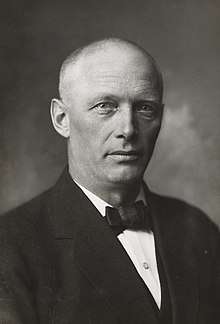
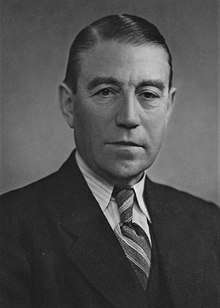

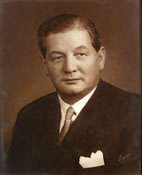
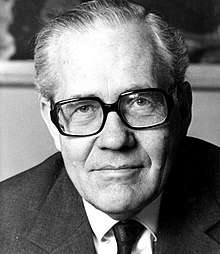
.jpg)

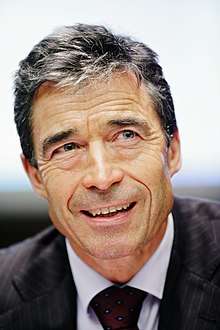
_(cropped).jpg)

